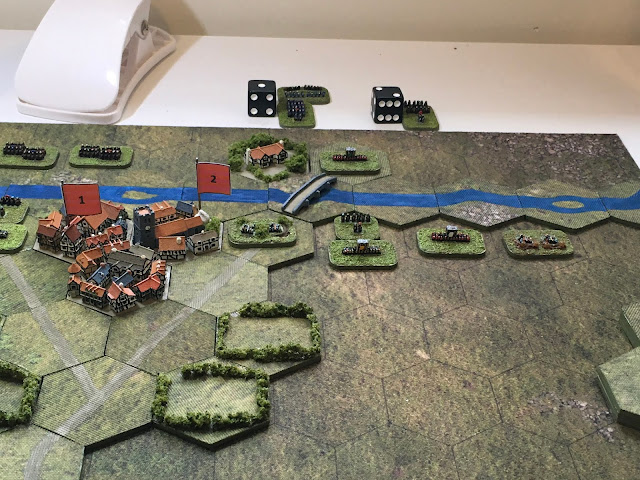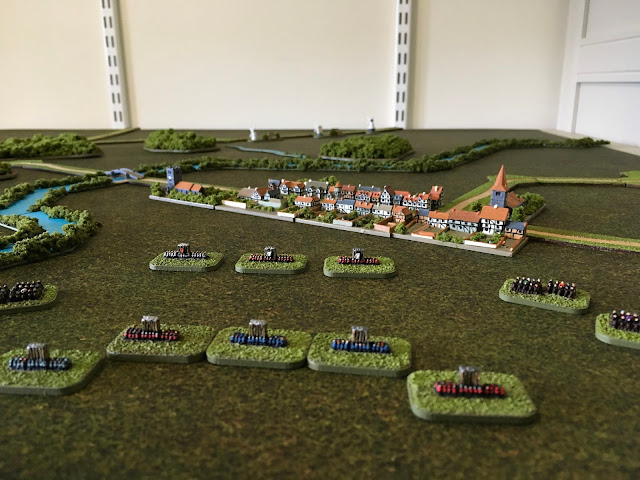I’ve been on a bit of an ECW tip lately and have been experimenting with a number of published and unpublished rules. The main thing to come from all this dabbling was the realisation that nothing matched up to Msr Foy’s excellent C&C ECW set. The built in card mechanic suffices as a crude A.I, the game itself doesn’t overly tax my noggin’ and of course there’s hexes…lots of lovely hexes!
Now my original C&C cards are still, I suspect, in La Maziere Aux Bons Hommes, and the only ECW forces I own these days are my 2mm ones, so a degree of work was required to get things up and running. After a four week wait for a new 2ft x 1.5ft game mat and a whole heap of printing…I’m finally there.
Elenderil over at “Small But Perfectly Formed” kindly let me nick a map and set up of his from a 2mm game he ran back in 2018. I’ve twisted it through 90 degrees to better fit with the hexes and altered some of the forces to accommodate the C&C model - otherwise everything else remains broadly the same.
The situation:
It’s 1643 and a Royalist force is making its way out of Wales in order to reinforce the King at Oxford. At a river crossing into the Midlands they find their way blocked by a small Parliamentary army.
Objectives:
The Royalists will earn 3 Victory Banners for each bridge hex they occupy, plus 1 Victory Banner after that for each turn they remain in occupation of it. The Parliamentarians will earn 1 Victory Banner for each Royalist unit they destroy. The game ends automatically with a win for the side that is the first to score 5 Victory Banners.
Parliament’s forces set up first and are controlled directly by the C&C cards, the Royalists set up second and are controlled by me. The Roundheads may deploy anywhere within the first three hex rows, the cavaliers within the first two.
 |
| Put yer specs on! |
 |
| The battlefield seen from the Royalist left flank. |
 |
| Elenderil’s original map of Bridgetown |
Both factions are allowed four command cards in their hand at any one time.
Terrain: The river may only be crossed via the bridges.
Forces:
Parliament
3 x artillery - trained
2 x horse (Dutch tactics) - trained
2 x horse (Dutch tactics) - raw
1 x dragoons - trained
2 x foot - raw
2 x foot - trained
1 x C in C
3 x leaders
Royalist
3 x artillery - trained
1 x horse - veteran
4 x foot - trained
2 x foot (small units) - trained
5 x horse (small units) - trained
1 x C in C
4 x leaders
 |
| Told you you’d need your specs. Parliament’s left flank deployment with artillery covering any approach down the road. |
 |
| Parliament centre. The numbered flags indicate which of two units behind the map occupy the building hexes since the unit bases won’t fit between the houses! I’ll use this system for woods as well. |
 |
| Parliament right flank, with two horse regiments in reserve over the river and a series of enclosures bordering the road. |
Game rule tweaks:
No plan survives contact with the enemy: I will initially choose two of the cards from my four hand allowance to support my overall strategy, thereinafter I will make the best use of fresh cards that are drawn from the deck.
The element of surprise: The Parliamentary player will have his command cards dealt blind and left face down. 1 card will be revealed from his hand each turn and acted upon. Once used and discarded it’s replacement will also be concealed. The status of Parliamentary units (raw in this case) will only be revealed when a unit becomes involved in combat. Status will be determined by die roll - a process that will cease in this particular game once two foot and two horse units have been marked up.
Size doesn’t matter: Small units lose 1 combat dice and have one less hit capacity than a regular sized unit. For example, a normal sized foot regiment can absorb three hits before destruction, a small foot unit only two. Correspondingly, large units can absorb 1 extra hit before destruction, though none are listed as such in this scenario. Note a unit may always roll 1 fire combat dice.
Range reduction: Given the scale of the units, muskets may only be fired into an adjacent hex, not two hexes as per the regular rules, this effectively reduces foot to a melee capability only but veteran units gain +1 combat dice anyway, perhaps reflecting firing by salvee.
Preemptive fire: Trotter (Dutch tactics) cavalry being charged by galloper (Swedish tactics) cavalry may fire at their attackers before they enter into melee - however the attacking unit may not start from an adjacent hex. The trotters (not Del and Rodney) may roll 1 combat dice whose results will impact the charging gallopers before the melee they are instigating takes place. If preemptive fire is utilised then the trotters must deduct 1 die from their usual melee battle back allowance. Note a flag result from preemptive fire will cause the gallopers to pull up short and not enter melee even if a leader is attached to the unit.
Foot and commanded shot may adopt a similar tactic unless raw.
A unit may only use preemptive fire once per turn.
Since I now have the luxury of leaving this pocket handkerchief sized battlefield out for as long as I want I’ll cover the Royalist deployment and the battle itself in the next post. Hopefully the brief delay will allow you to make a quick visit to Specsavers. Lol.
TTFN

























